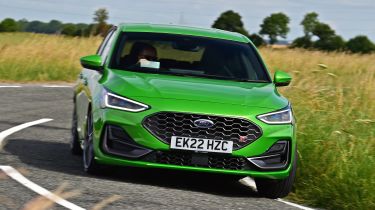Farewell Ford Focus ST: production of iconic hot hatch ends
It’s the end of an era for the Ford Focus ST, with iconic performance model following the Fiesta ST into history

It's the news no enthusiast wanted to hear: the Ford Focus ST is no more. The final example of the fast Ford rolled off the Saarlouis assembly line in Germany on 26 September, marking the end of a hot hatch lineage spanning more than two decades.
The writing has been on the wall for the Blue Oval's performance models across Europe. The Focus ST order books were closed months ago, and its demise follows the decision in 2023 to discontinue the beloved Fiesta ST, as Ford phases out its ‘traditional’ hatchback models. CEO Jim Farley recently defended the cuts, stating that the company was not making "any real money" on these cars, despite the fervent customer base.
The impact on Ford's European presence is stark, with its market share now sitting at a low of 3.3 per cent, behind rivals like Hyundai and Kia. With regular Focus production ending completely in November, the long-term future of the Saarlouis plant remains under review, though it is currently slated to stay open until 2032.
If you fancy a Focus ST, you can explore an array of used models through the Auto Express Buy A Car service, starting from just £8,000.
Ford Focus ST generations
The Focus ST’s retirement closes the chapter on one of the most compelling stories in modern hot hatch history.
The ST badge first appeared in 2002 with the Mk1 Focus ST170. As a medium take on the hardcore RS, its 167bhp 2.0-litre Duratec engine wasn't the liveliest, but combined with the already brilliant Mk1 Focus chassis, it delivered an incredibly sweet and compelling package.
Things went in a different direction with the 2005 Mk2 Focus ST. This generation was bigger, heavier, and arguably less delicate, adopting a more thuggish charm backed by a charismatic 222bhp, 2.5-litre five-cylinder turbocharged engine. Sharing its architecture with the RS that followed, it was a proper GT hot hatch that had buyers questioning if they truly needed the flagship fast Ford.
The Mk3 ST of 2012 proved to be a rare stumble for Ford. Its 247bhp 2.0-litre four-cylinder engine lacked the character of its five-pot predecessor, and the chassis struggled to deploy the power effectively, resulting in a frustratingly compromised drive.
Thankfully, the Mk4 corrected the ST’s course. Launched with 276bhp and 420Nm of torque, it successfully re-injected control and precision and, while it perhaps couldn't match the all-out pace of a Honda Civic Type R, it was a cohesive whole, demonstrating a welcome return to form for the fast Focus.
The shrinking hot hatch scene

The Focus ST is the latest casualty in the rapidly shrinking European hot hatch segment, joining the recently axed Honda Civic Type R (due to stricter emissions), Hyundai i20 N and i30 N, and the long-gone Peugeot 308 GTi.
While some options remain, including the Volkswagen Golf GTI/R, Cupra Leon, and Audi S3/RS3 Sportback, the future looks increasingly bleak. With tightening emissions regulations and 2030 marking the end of new combustion car sales in the UK, petrol-powered hot hatches are a dying breed.
Ford has pushed the ST badge onto the Puma ST, but while the compact crossover is dynamically sound, the mild-hybrid powertrain (with dual-clutch auto ‘box) that has replaced the 1.5-litre, three-cylinder engine (with six-speed manual transmission) means it’s a shadow of its former Fiesta-based self.
As automakers focus on electric alternatives, like the Abarth 500e, Hyundai Ioniq 5 N, Alpine A290 and VW ID.3 GTX, it's clear the glory days of the mass-market petrol hot hatch are officially over. The Focus ST will be sorely missed.
Get the latest and best car news and reviews, first! Follow Auto Express on Google today
Find a car with the experts








